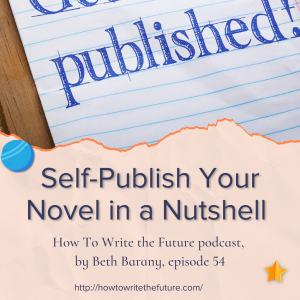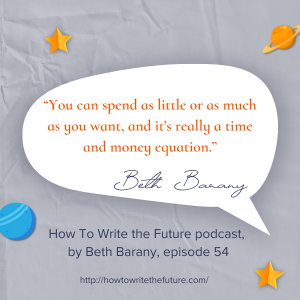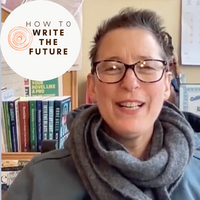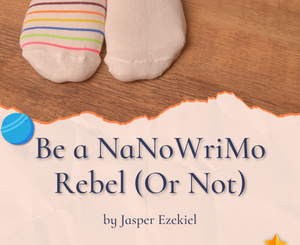Self-Publish Your Novel in a Nutshell
Self-Publish Your Novel in a Nutshell – How To Write the Future episode 54
“You can spend as little or as much as you want, and it’s really a time and money equation.”
In “Self-Publish Your Novel in a Nutshell” host Beth Barany, creativity coach, and science fiction and fantasy novelist shares a short summary of the key elements you need to self-publish your novel including resources that can help prepare you for your publishing journey.
Platforms the podcast is available on Apple Podcasts | Google Podcasts | Buzzsprout | Spotify | Podcast Addict | Amazon Music | Youtube
RESOURCES
Free World Building Workbook for Fiction Writers: https://writersfunzone.com/blog/world-building-resources/
Sign up for the 30-minute Story Success Clinic here: https://writersfunzone.com/blog/story-success-clinic/
Get support for your fiction writing by a novelist and writing teacher and coach. Schedule an exploratory call here and see if Beth can support you today: https://writersfunzone.com/blog/discovery-call/
The Benefits of Working with a Fiction Writing Coach – https://writersfunzone.com/blog/2023/07/03/the-benefits-of-working-with-a-fiction-writing-coach/
ABOUT THE HOW TO WRITE THE FUTURE PODCAST
The How To Write The Future podcast is for science fiction and fantasy writers who want to write positive futures and successfully bring those stories out into the marketplace. Hosted by Beth Barany, science fiction novelist and creativity coach for writers.
Tips for fiction writers! This podcast is for you if you have questions like:
- How do I create a believable world for my science fiction story?
- How do I figure out what’s not working if my story feels flat?
- How do I make my story more interesting and alive?
This podcast is for readers too if you’re at all curious about the future of humanity.
Transcript for Self-Publish Your Novel in a Nutshell
Are you looking for a way to dig into your world-building for your story?
Then I recommend that you check out my World Building Workbook for Fiction Writers. Now available.
It’s at How To Write The Future.com.
Just head on over there. Click, sign up. Put your name and email, and there you go.
That workbook will be delivered to your inbox straight away.
***
Hey everyone, Beth Barany here for How to Write The Future podcast. The focus of this podcast and the focus of my work is to support science fiction and fantasy writers to create positive, optimistic futures. Because when we vision what is possible, we help make it so. This podcast is also for anyone who cares about the future and who cares about making the world a better place for future generations.
I’m really excited to bring you this short episode today about self-publishing your novel in a nutshell. Not that you’re self-publishing inside of a nutshell.
This is a very short episode to explain the key elements of self-publishing. I just want to let you know that I recorded this while I was walking from my house to the cafe in response to the need of a client. And I recorded this back in 2014, so I did cut out some things that no longer exist, basically, some technology and tools that don’t exist anymore. But the key information on editing and prepping your book for marketing is absolutely the same.
So keep in mind, this is just a very short summary of everything that you need for self-publishing.
If you have more questions, please, please reach out to me. And I will either support you directly with resources that I already have or point you in the right direction if I don’t have them.
If you’d like someone to help you self-publish, I take a few clients as a self-publishing consultant and producer. So check in with me and see if we’re a good fit. I’d be happy to have that conversation. How to set up a call with me will be in the resource section.
All right. Enjoy this episode. And happy writing and happy publishing.
Self-Publishing – What to Think about
One of my clients today asked me to tell her about self-publishing, kind of chuckled and asked her, well, where do you want me to begin? And then she’s like, gosh, I don’t know. And she waited for me to fill in the blanks. So I did.
In about 10 to 15 minutes, I gave her a rundown of everything that she needed to think about if she wanted to self-publish her young adult fantasy novel.
So here’s what I said in summary.
I said, well, the first thing that you wanna do is make sure your book is edited. She was concerned about costs. She said I heard that self-publishing is way more expensive than traditional publishing. And I said, well, that depends. Depends on your budget.
You can spend as little or as much as you want, and it’s really a time and money equation. You’re gonna either spend a lot of time and do it yourself. And get your friends to help you, or you’re gonna spend money and have people do things for you, or you’re gonna do a combination of the two.
And seriously with a good, writing community around you and reaching out and asking for help at various moments, your budget can be quite small for self-publishing.
And yes, that does mean you will have to put your time into the project.
You’re now entering the world of commerce
Keep in mind, if you’re gonna self-publish, whether you’re a fiction writer, which is my specialty, or non-fiction writer, either way or in any genre, memoir, poetry, you are now entering the world of commerce and you are now entering the world of business.
So that means you need to understand the publishing industry, book marketing, how to reach your audience, all things that anybody who wants to sell something needs to understand. So back to the chain of events.
So there you are. You have your book, it’s finished. You feel like it’s finished, but you’re not sure. Is it publication-ready?
So, you want to either hire an editor or have a critique group, or both, to help you make sure that your book is a compelling read, error-free, that you’ve put thought and care to every single word in that story.
When you see a book on the shelf, the library, or the bookstore, they have been heavily edited usually. And of course, in modern-day times, you’re gonna find books with typos. That’s because they weren’t properly edited.
Two Main Kinds of Editing You Need
So just a bit on editing. You’re gonna wanna make sure, there’s two main kinds of editing.
There’s story editing. Making sure your story is interesting, your characters are interesting, your plot is interesting.
And then you’re gonna wanna have people help you with typos and, making sure your word choice is appropriate. And people often call that copy editing. I, for one, am very weak on noticing typos and, even homonyms, where I’ve used the same, spelling, like two and too, and things like that. I won’t even always notice that I also reverse words. I don’t always notice that in the revision phase. So I always have someone helping me with that, and I will hire a copy editor to help me fix those mistakes.
I use a critique partner. I use beta readers.
Beta Readers
Beta readers is something you’re gonna wanna have. When your book is done. Now it’s been critiqued, it’s been edited by you. You feel good about it, you think it’s publication-ready? Well just wait. Get some beta readers to make sure that your book is ready.
These are people who love to read. Sometimes they’re writers. And they wanna be part of the early phase, so they wanna read your book. And we ask them very simple questions. We’re not asking ‘them to make any fixes unless they can’t help themselves. And there are people like that who can spot a typo, but they’re not editors, but they’re very good at catching errors.
Really what we wanna know is if they enjoyed the story, if there’s any part of it where they lost interest or didn’t feel believable, or just wasn’t working for them. So that’s editing. So there you are. You’ve got your book completely editing, it’s ready to go. It’s in manuscript format, just in a Word document on your computer, or in a Word program, a writing program of some kind.
Now what? Okay, so there’s two tracks. There’s ebook publishing and there’s print publishing. In my opinion, these are two ways to get your book out and two ways that are essential. Of course, there’s other versions of publishing too. There’s audio, there’s serial fiction, and I’m sure there’ll be more kinds of publishing your story than I can even think of because we’re creatives, right?
E-Book Publishing
So, e-book publishing. You can upload your manuscript to a site like draft2digital, and it will convert it for you, and it will even put it up on the vendor sites, Amazon, Barnes and Noble. iTunes. Awesome, right? Great. So easy. Technology’s made it so easy to publish today. There are a few things you need to prepare before you do that.
Your Meta Data
Number one: You need a title for your book and in some cases a subtitle. Of course, you need to have an author name, which is usually your name, although some people want pen names. That’s something to consider. You need a cover. A cover is a very important marketing tool, as is the title. Everything we’re gonna talk about now is about marketing.
So you have title, you have a cover that you need to have appropriate for your genre, its own huge conversation, and you need the book blurb, the book description, which is a sales tool. You need to write that. You need an author bio that’s also shows you off. This is also a sales tool. Then you need to know what categories should the bookstores put your books in, and what are the keywords. This is for helping people find your book.
Put all of that information into one document– this is all called the metadata– and will follow your book to every vendor site, whether it’s Amazon, Books a Million, Barnes and Noble. You do need to spend time on this with careful thought and consideration as you did to your book.
This is all the marketing material that will help sell your book.
Once you have that and your cover ready, you can upload everything into draft2digital.
So that’s for eBooks.
Print Publishing
For print, if you want to nerd out, there’s lots of information online about layout. There’s a wiki for book design that I used when I first started designing books. Amazon can print your book. There’s also Ingram Spark. It’s a print-on-demand service like a lot of others out there. And you only need to print the books that you need so that you can sell them at your events or book signings.
Do give yourself four to six weeks to upload your books. With digital, it takes 24 to 48 hours to get your books up.
With print, it can take a few weeks, depending on how many drafts you want to look at. I do recommend that you ship yourself a book before you publish to make sure that you like what you’ve created.
So there’s the rundown on self-publishing.
What to Price Your Book
There’s one more element I forgot to put in the metadata, which is price. When you think of an ebook price and a print price, they’re not the same. And for all of this, see what your fellow authors in your genre are creating. Make sure that your cover is attractive to your readers.
Make sure your price is a no-brainer. Don’t price your book way outside the range of what your compadres, your cohorts, and your genre are charging unless you have a very good reason for that.
Join A Writing Community
All right. Do join writers’ communities in your area, online, in your genre, so that you can get support, you can trade business ideas and marketing ideas, and just commiserate with other writers.
That’s my low down on self-publishing on November 24th, 2014.
Stay tuned. These things will change. I’m sure. Bye-bye. Happy writing. Happy publishing.
And there you go. Self-publishing. In 10 minutes on the streets of Oakland by Beth Barany creativity coach for writers, award-winning novelist, and creativity entrepreneurship junkie.
Thanks for playing!
Have a fabulous, fabulous week. I look forward to connecting with you next time in our next How To Write The Future episode.
Thank you so much, everyone, for listening to my podcast. Your interest and feedback is so inspiring to me and helps me know that I’m helping you in some small way.
So, write long and prosper.
***
Are you stuck and overwhelmed by world-building?
Then check out my new World Building Workbook for Fiction Writers.
Head over to HowToWriteTheFuture.com and sign up for yours today.
Loved this episode? Leave us a review and rating here: https://www.buzzsprout.com/2012061
ABOUT BETH BARANY
Beth Barany teaches science fiction and fantasy novelists how to write, edit, and publish their books as a coach, teacher, consultant, and developmental editor. She’s an award-winning fantasy and science fiction novelist and runs the podcast, “How To Write The Future.”
Learn more about Beth Barany at these sites:
Author site / Coaching site / School of Fiction / Writer’s Fun Zone blog
CONNECT
Contact Beth: https://writersfunzone.com/blog/podcast/#tve-jump-185b4422580
Email: beth@bethbarany.com
LinkedIn: https://www.linkedin.com/in/bethbarany/
CREDITS
EDITED WITH DESCRIPT: https://www.descript.com?lmref=_w1WCA
MUSIC: Uppbeat.io
DISTRIBUTED BY BUZZSPROUT: https://www.buzzsprout.com/?referrer_id=1994465
SHOW PRODUCTION BY Beth Barany
SHOW NOTES by Kerry-Ann McDade
***
For more “How To Write the Future” episodes, go here.
If you’d like to invite Beth onto your podcast, drop her a note here.






